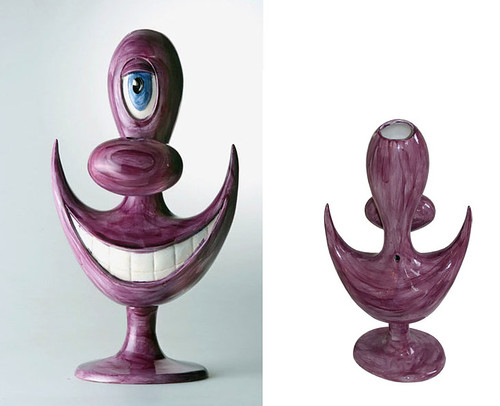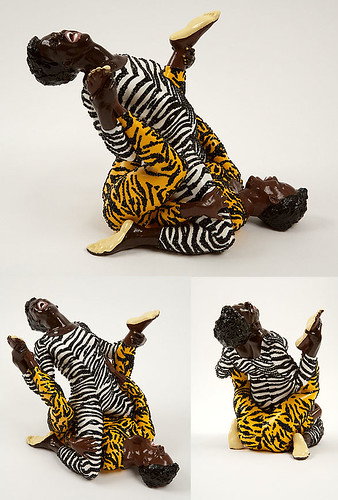
Mickalene Thomas, Brawlin Spitfire Wrestlers 2007, Resin, paint, and Swarovski crystals, h: 10 x w: 14 x d: 9.8 in
Who makes money off all the merch that’s based on artists’ imagery? Roberta had put up a post-ette about Robert Indiana’s Love sculpture imagery becoming public property, with the artist not getting a dime off of all the t-shirts and pins and posters.
So I began to wonder about the whole business of art reproduction and copyrights and multiples and how it all works.
ultra-hip local producer and purveyor of high-end, 3-D art multiples–Larry Mangel of Cerealart (and Cereal art at artnet is here).
Mangel’s little store front is a jewel box out of which he and his small staff, which includes his daughter Shiya, move tons of merchandise. Last time I stopped in was right after Art Basel Miami, and the place was piled high with cartons of merchandise, still being sorted and unloaded after its return from the fairs.
He also runs the back room, the Project Room, as a little gallery, with his many art-world connections doing some of the curating for him.
I called him (golly, it’s already a month ago!), and here’s what he had to say.
Libby: So how come Robert Indiana doesn’t get a dime for all the Love merch in Philadelphia?
Larry: I think once an image becomes part of the public domain, it becomes a public image that anyone can use,like what happened to R. Crumb’s Keep on Trucking image.
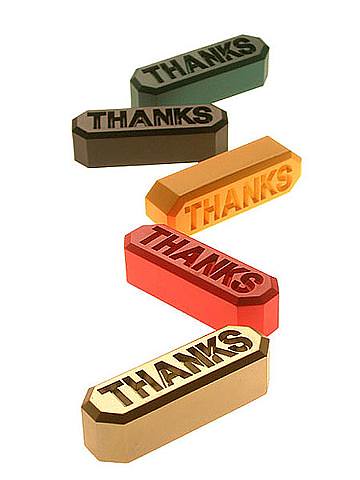
Allan McCollum, Thanks, an open edition Cerealart multiple, Solid Resin, Each Bar – 3.75 in l x 1.25 in w x 1 in h
Libby: So what’s your ownership of the multiples you make?
Larry: We don’t buy the copyright; we license the copyright. So the artist always owns the copyright. The open edition ones are on a royalty system–like a design royalty, into perpetuity. The only thing we can really own is if we trademark the name. That would be come an asset of the company.
We haven’t done open editions in a while.
Libby: Do you suggest to the artists how you’re going to work with them?
Larry: When we decide we want do something, we sit down with the artist. Each deal is different. Some are small editions, signed. It’s done the same way you would do a print.
If a gallery published a print, they would split the profits with the artists, less the cost of fabrication. Our fabrication costs can get really high. Sometimes fabrication is involved, and we do a straight percentage. The artist gets a percentage of the sale price.
For a large edition, they get a lower percentage.
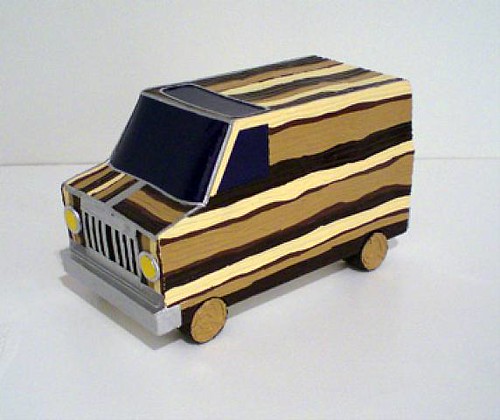
Chris Caccamise, Home Made Vehicle (Van), Paper, enamel and glue, h: 8 x w: 4.5 x d: 5.5 in
Libby: How do you pick who you’ll work with?
Larry: There’s no real system. I look around the art fairs, I ask the artists to do something.
Libby: So what kind of deal do you have in relation to the artists’ galleries?
Larry: Sometimes the galleries get a couple of artists proof, sometimes a discount. Sometimes, they are happy to get their artists out to another audience. Usually the galleries just let us be.
Now the artists are so independent, they can just really do it on their own.
Libby: What’s the relationship of someone who purchases a piece to owning it?
Larry: The person who bought it is not allowed to make a multiple of it without your permission. I think you still own the copyright to the image if you’re the artist. You couldn’t buy a Warhol painting and scan it in and say, I’ll make a hundred of them. You’d get sued.
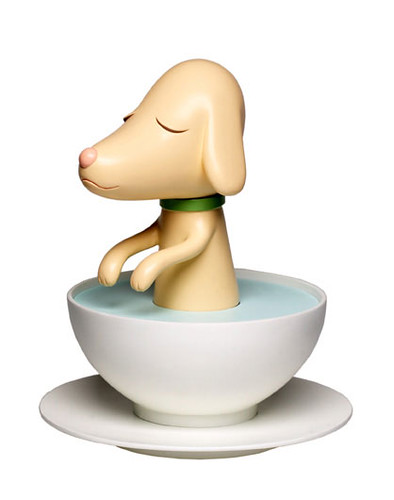
Yoshitomo Nara, Pupcup, Injection molded and Rotomolded plastic, h: 9.5 x w: 8 x d: 8 in
Libby: What’s the background on this business?
Larry: In the early ’90s, I was at, Lawrence Oliver Gallery. We were selling things all over the world. when the art world contracted, so we closed.
Philadelphia’s a tough sell. At Lawrence Oliver, we sold all over the world, not in Philadelphia. Donald Judd we had 12 works and maybe five good local collectors. Seven pieces were left. People would call from Tokyo, Sweden. We used to advertise in Art Forum.
Once the art market slowed down, people could get the work from the New York dealer or from the studio. There was no reason to come to Philadelphia for it.
I was frustrated, and had the idea. My wife was working for Zany Brainy. I went to visit original-art dealers in the American Armory show. It was the same time as the toy fair, and something hit me. I bet we can make objects that we could sell to a different audience when they won’t come in a gallery to buy art. How do you get things out to the world? I was out of work, really. How do you get people’s attention?
It was the time of the first Iraq conflict. I started making art toys. I watched how Richard Serra and Donald Judd fabricated things. I was interested in …conceptual, not hand-sculpted, in how to make the process more mechanical. As we got experienced, artists started to trust us.
First Nara asked us to make his sculptures. We said, Are you sure? One of the first pieces we made in 2002.
Almost every project requires learning a new process, new technology. Over the past 10 years, we’ve used fabricators in South American, China, Thailand and Europe. Now we are making more and more things in Philadelphia.
Libby: How many artists are you working with?
Larry: 25 or 26. I’m not really sure how many things we have. We’re adding and subtracting all the time. We started out with more playful objects. Most things we do, even now, have some sense of humor.
The most exciting part of the business is making a deal with a new artist.
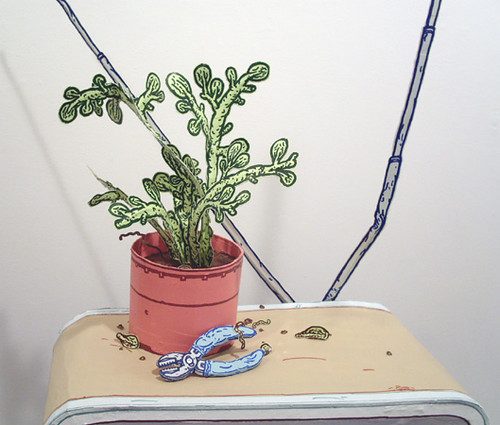
Libby: Who’s new?
Larry: Olaf Breuning. I’ve seen his work in different places. We wanted a few more European artists. He’s living in New York. I did a studio visit, and he was invited to the Whitney Biennial [we raved about him in a post here; the Whitney work seems atypical]. He shows at Metro Pictures and has an interesting sense of humor.
Libby: Anyone else?
Larry: Chris Caccamise‘s paper sculptures, Shinique Smith.
We did weird printed paper sculpted plants by Taylor McKimens, who shows at Clementine‘s. They are true drawings in space.
Libby: Are you the only operation doing these 3-D editions?
Larry: Parquette [sp?] does 3D editions for the magazine. They are more expensive than what we do.
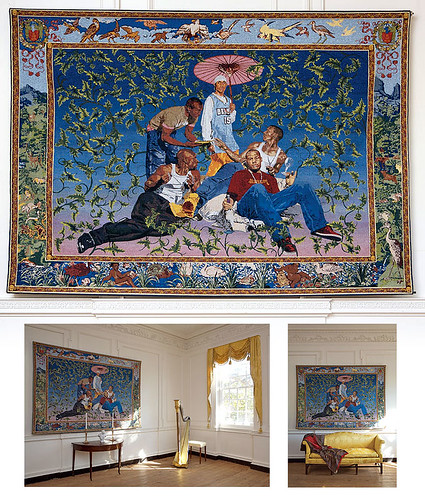
Kehinde Wiley, The Gypsy Fortune-Teller, 2007, Tapestry Woven in Belgium, 76 x 102 inches, edition of 48. Powel House cuortesy of the Philadelphia Society for the Preservation of Landmarks, Landmarks contemporary Projects. Photo credit: Aaron Igler
We try to keep things reasonable. It’s $20,000 for the Kehinde Wiley tapestry [he sells in the six-figures these days], which is an edition of 48. We sold the 22nd or 23rd today (that was February 14).
Libby: Who buys them?
Larry: Some people buy them because they work great in public spaces. Some Kehinde Wiley collectors, too. The work really lends inteself to the medium. He’s recontextualizing African-American images in art historical contexts, in this case he’s using a Boucher composition from a piece in the Met’s tapestry show.
I met Micky [Mickalene] Thomas via Kehinde. I went to Art Basel in 2006 and saw her work and Rhona Hoffman. I bought a photo and was really happy. We will be making three bigger than life-size versions of the wrestlers, 7 to 8 feet high.
Libby: I know she’s from Camden.
Larry: She went to Pratt, in Brooklyn, and is in her mid-30s. She’s very hands on. [Philadelphia sculptor] Chris Smith does a lot of figures for us.
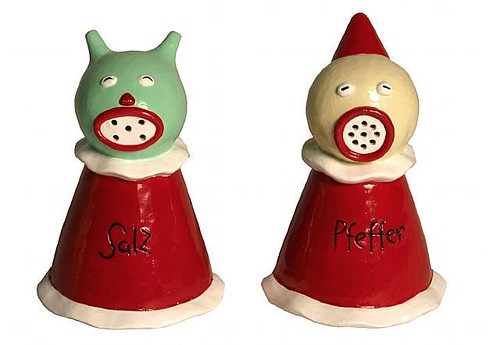
Marcel Dzama, Sea Salt & Jester Pepper Shakers, 3 inches high
Libby: You mentioned you try to keep prices down. So what’s less expensive?
Larry: Allan McCollum‘s things go for $40 or $50 dollars. The Marcel Dzama salt and peppers–the jester ones–for $75. His action figures are $30. The Nara glasses are $20.
Libby: You have a storefront in Old City. Do you get any people who just wander in and then buy?
Larry: People come in off the street. Usually art collectors call. I’m fascinated by the people who buy on the web site. our customers include some famous people as well. They come mostly through the web and the art fairs.
I’m grateful that they let us into the art fairs, because it’s so competitive. We don’t really sell much on 3rd Street.
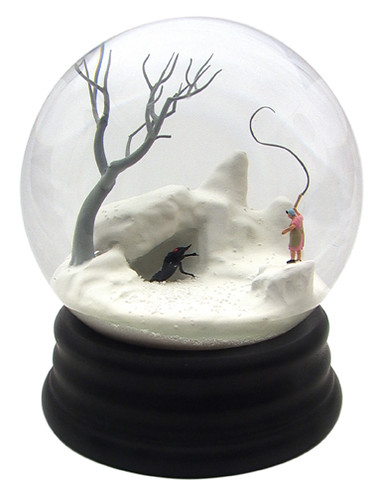
Walter Martin & Paloma Munoz, Traveler 191, 2006, Glass, resin, injection molded plastic, wood, and water, edition of 250, Globe diameter: 4.75″
In little shows [in the Project Room] we’ve been showing, and are surprised at how many things sold. Walter [Martin] & Paloma [Munoz]‘s snow scenes–all 4 pieces stayed in Philadelphia.
The Jonas Wood show [with Chris Caccamise in the Project room in the back of Cerealart], he was hot and the word got out. Three or four sold in Philadelphia, plus we got lots of queries.
Maybe if you’re located on the Bowery you can make enough things fast enough so you don’t sell out and cover the costs of being in New York. People come down for the weekend and buy stuff here. I don’t know if they see our sign?
We finance everything. There’s no expense to the artist at all. We manage the project and we sell it.
We work with many of Jeffrey [Deitch]‘s artists. We’re interested in pop culture. We made those pipes for Kenny Scharf.
The whole idea of the company is Warhol influenced. We were going to name it Serial Art, with an s, but it sounded sinister or something, like serial killer.
It’s fun to make things that get out to the world and a wider audience.
Eighty percent of the art audience, maybe 90, are people who follow the artist but can’t afford one-of-a-kind things. Or there are people who can afford it but don’t know how to get it because there’s no work around.
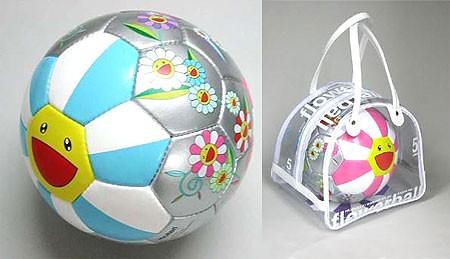
Takashi Murakami, Flower Ball Soccer Ball and translucent carrying case (ball is a size #5)
Ten percent fall in by chance, are fascinated, and can afford to buy something. I guess everyone has some interest in the art world. We do have people who stop by and fall in love with something. The Murakami soccer balls sold when the bags were the rage–the appeal crossed over to fashionistas.
People buy Nara clocks; it’s a fun thing.
Sometimes people say, those images aren’t really for my 10-year-old.
Libby: What’s next?
Larry: My next show is Willy Smith, a good young painter. Sean Murphy, a painter from Dublin, will be doing an exhibition. My daughter is putting together a print portfolio for Youth AIDS and the Cambodian Children’s Fund. The portfolio will have 8 to 10 artists, 25 sets, all different processes–photography, etching, lithography. It’ll include Kehinde, Mickalene, Shinique, [Jeremy] Deller, Scharf. We’re trying to dotate it all the profit, so we’re hoping we’ll just cover the printing costs.


